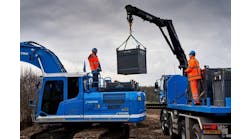Briggs & Stratton Commercial Power this month introduces four new Vanguard single-cylinder engines with gross horsepower ratings ranging from 5.5 hp to 10 hp. The company previewed the new engine line-up to RER at its recent Van Prix editor event in Elkhart Lake, Wis.
The new engines were designed using input from Briggs & Stratton customers to address the top worksite challenges experienced by end-user customers and OEMs — heavy dust, lack of regular maintenance, filtration issues and oil dilution during transportation.
“Our approach to product development is to stay connected to the customer,” says Dan Roche, marketing manager with Briggs & Stratton Commercial Power. “Our work in the field helped define the design criteria for these new Vanguard engines. By listening to customers and working with OEMs, we have developed an engine series that will raise the standard of dependability in the toughest jobsite situations.”
To start, Briggs & Stratton asked rental business owners three questions related to equipment engine issues: What are the main reasons why equipment won't start when a rental customer calls from the field? What are the most common engine-related problems found after equipment has been rented? What are your top five overall equipment maintenance-related issues?
Among the top five responses to all three of those questions was “fuel has mixed with oil during transport.” This occurs when the engine vibrates during transport, which can cause fuel to flow through the engine and into the oil, drastically reducing viscosity, resulting in more friction, increased wear and shorter engine life. To address this problem, Vanguard engineers created an integrated switch that simultaneously shuts off the ignition and the fuel. Named the Transport Guard, this patent-pending system is designed to ensure that fuel stays where it belongs and helps eliminate fouled plugs, hydraulic lock, cylinder wash down and crankcase oil dilution caused by transportation. This saves equipment owners and rental companies money by decreasing downtime and engine repair costs.
Briggs & Stratton engineers designed each component and integrated technology to work together efficiently to raise durability and reliability standards. A high-mounted canister-style air cleaner has 27-percent more filter area than competitor units, and an all-metal fuel tank reduces emissions, saves fuel and is mounted directly to the engine block, the company says.
To help understand the engineering of the new Vanguard single-cylinder engines, Briggs & Stratton engineers led editors step by step in tearing down the engines. In the process, additional features and benefits targeting durability were pointed out including the water-repellant triple-seal design air filter, protected by a full metal cage, to dramatically decrease dirt, dust and debris intake. A large sediment filter collects sediment in a clear bowl that then drains easily through a convenient no-tools valve, and a commercial-style carburetor includes additional fuel passages to assure easy starting and smooth operation at a wide range of speeds and loads.
For reliable jobsite performance the new Vanguard models feature larger ignition coils designed to ensure fast, easy starts and the full skirt rewind allows more airflow while restricting dirt and debris intake. The airflow generated by the high-capacity fan is 15-percent greater than non-Vanguard engines. In addition, a motorsports-proven rod/dipper design efficiently improves oil flow throughout the engine assuring maximum protection of component parts, and an oil sensor automatically shuts down the engine in low oil situations — a safeguard designed to greatly extend engine life.





